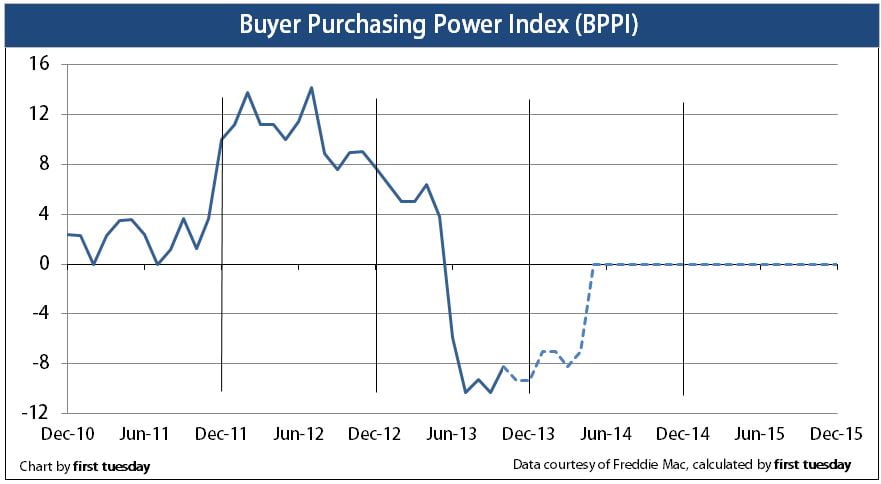The California buyer purchasing power index (BPPI) figure increased to -8.2 in October 2013. first tuesday forecasts the BPPI will remain negative through mid-2014, when it will likely return to zero, stopping a year-long loss of buyer purchasing power.
A negative index figure translates to a reduced amount of mortgage funds available. The BPPI is calculated using the average 30-year fixed rate mortgage (FRM) rate from Freddie Mac (Western region) and the median income in California.
October’s index figure represents a year-over-year decrease of 8.2% in mortgage funds available to today’s buyers. This is up slightly from -10.33 in September and down from +8.93 one year ago, when BPPI was near its height.
The sudden drop is due to the recent steep rise in mortgage rates, which was cooling off as of the end of October 2013. However, the average 30-year FRM rate remained nearly a percentage point higher in October 2013 than one year earlier.
Buyer purchasing power is down a further 30% for buyers of low-tier homes, 24% for buyers of mid-tier homes and 19% for buyers of high-tier homes due to a 16-month rise in home prices. Pricing conditions are temporarily positive for sellers since the upward home price momentum will persist a couple more months due to buyer expectations.
By the end of 2013, pricing will trend flat or down, a result of reduced purchasing power, price increases beyond the rate of consumer inflation (payrolls) and waning market participation by buyer occupants.
In 2015, the BPPI will continue a decades’ long period of negative descent which began prematurely this June, as long-term rates rise consistently with renewed growth in our dynamic economy. Sellers will continue to experience downward pressure on prices, as buyers will be able to borrow less over the coming decades with the same income.
Chart update 11/04/13
| Oct 2013 | Sep 2013 | Oct 2012 | |
| Buyer purchasing power index (BPPI) | -8.2 | -10.33 | +8.93 |
About the BPPI
A positive index number means buyers can borrow more money this year than one year earlier.
A negative index figure translates to a reduced amount of mortgage funds available.
An index of zero means there was no year-over-year change in the amount a buyer can borrow. At a BPPI of zero, homebuyers cannot purchase at higher prices than one year before unless they resort to adjustable rate mortgages (ARMs) or greater down payment amounts.
To keep the homes-for-sale inventory moving at the same pace, sellers will have to lower prices or pull their properties off the market. Around 0.25% of California’s 6.8 million owner-occupied SFR inventory are listed for sale monthly.
As BPPI declines in the current trend, the capacity of buyers to borrow purchase-assist funds is reduced. In turn, buyers needing purchase-assist financing can only pay a lesser price for a home.
—
first tuesday journal online is a real estate news source. It provides analyses and forecasts for the California real estate market, and has done so since 1978.














